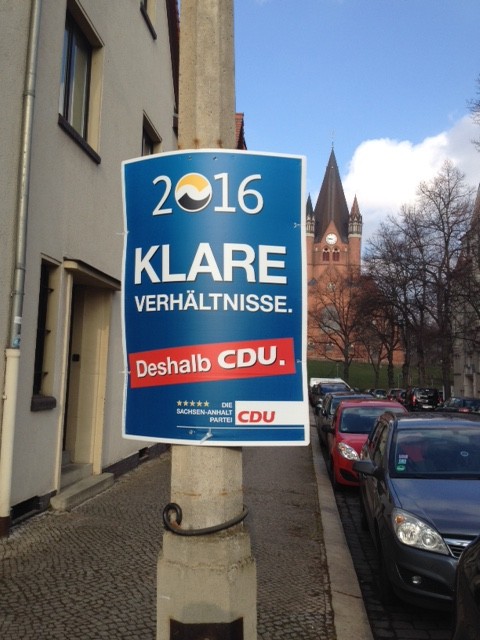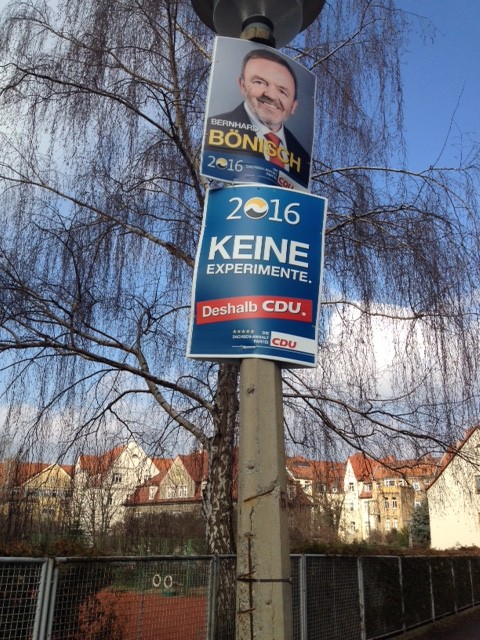Regional elections in Germany have seldom if ever attracted as much attention as they did on Sunday, 13 March 2016. This was the first opportunity for the electorate to express its opinion about the “refugee policy” pursued by Chancellor Angela Merkel since early September 2015. Not only her own Christian Democratic Union but also the Social Democrats, her coalition partner in Berlin, lost votes to a new protest party, the Alternative for Germany. These “Rechtspopulisten” did especially well in Saxony-Anhalt, where I live. Rather than simply join the chorus of condemnation of this vile movement and celebrate the humanitarian altruism shown by the mainstream parties toward deserving foreigners, it behooves social scientists to analyze the deeper causes and consequences of both the voting and the migration patterns.
On Monday, 14 March 2016, the day after Germany’s regional elections, the front page of my local newspaper—the Mitteldeutsche Zeitung, published in Halle—was dominated by the success of the Alternative for Deutschland (AfD). This party did not even exist the last time voters had chosen their representatives to the regional parliament (2011). It had attracted a limited following during the long-drawn-out crisis of the euro, but the stream of refugees “welcomed” in Germany since September 2015 led to a strengthening of the party’s nationalist profile and brought it considerable notoriety in recent months. In Saxony-Anhalt, the AfD received almost one in four of all votes cast on 13 March 2016. Its young and inexperienced leaders—almost all male, many of them small businessmen (not all of these very successful)—do not have any semblance of a coherent political program. They relied on just one cause to garner them votes. With every major party lining up behind the refugee policy of Angela Merkel (though with some differences of emphasis), voting for the Alternative was the only way to show that you disapproved of her Willkommenskultur. Sober commentators and senior politicians of the mainstream parties huffed and puffed in the days that followed. Most agreed that the results would make Merkel’s job even harder and that the establishment parties would in future have to try harder to explain their policies to the electorate. Some commentators also suggested that, like other right-wing protest parties in past decades, the likelihood was that this nasty intruder would disappear from the scene in due course, perhaps even before the next elections.
I am not so sure. The three states that voted last month could hardly be more different. In all three, voter participation was significantly above that of 2011. In Saxony-Anhalt, it rose 10 percentage points to 61 percent. Participation was over 70 percent in the prosperous West German states of Baden-Württemberg and Rheinland-Pfalz, where the previous prime ministers, representing the Greens and the Social Democrats respectively, were re-elected. The Christian Democrats lost votes everywhere. There can be little doubt that their losses would have been even greater, had local leaders not repeatedly distanced themselves from Merkel (specifically rejecting her opposition to the idea of setting a ceiling on the numbers of migrants to be admitted). Despite this posturing, in Saxony-Anhalt the AfD scored 24 percent. The main losers here were the two parties of the left, the Social Democrats and the Left (the reformed ex-communist party, which remains strong in eastern Germany but generally fails to cross the 5 percent threshold in the western regions). The leadership of these left-of-center parties lined up squarely behind the refugees policy of the chancellor and evidently paid a high price for doing so (their combined share of the poll in Saxony-Anhalt was 27 percent). Merkel’s Christian Democratic colleague might have had to make way for an Alternative prime minister in Magdeburg, if he had not time and time again insisted that Saxony-Anhalt was full and made clear his opposition to taking in any more refugees.
The results unleashed a storm of criticism in the media all over the country. It was pointed out that, even compared with other xenophobic eastern regions, voters in Saxony-Anhalt had a particularly strong tradition of supporting extremist parties. My faculty colleague, the distinguished sociologist Reinhold Sackmann, interviewed by the Mitteldeutsche Zeitung, cited evidence for high levels of xenophobia in the east and warned against a “culture of chauvinism.” In other words, voters for the AfD in this regional election should have considered the negative repercussions of their support in a globalized world (interview, 16 March). The newspaper’s Chefredacteur was more explicit. On the day after the election, he wrote of a “political earthquake” and bemoaned the fact that:
There is a latent potential for hatred of foreigners in Saxony-Anhalt, which many have closed their eyes to, and which the AfD has reactivated … The AfD has already ensured in recent weeks that Saxony-Anhalt is increasingly perceived nationally and internationally as xenophobic (fremdenfeindlich). This effect will be strengthened by this electoral success. Business investments, especially international, will become more difficult. After this lurch to the right, scientists, skilled workers and students will reflect three times before coming here. Tourism—in the Luther year of 2017—will suffer in the same way.
Hartmut Augustin, the author of these lines, criticized the other political parties for not doing enough to debate the issues with the AfD, thereby allowing it to succeed with its policy of propagating fear. I term this kind of commentary “Saxony-Anhalt bashing.” It is not new, and it reinforces stereotypes held by most West Germans since unification.
The AfD is more than a noisy protest party: the völkisch rhetoric of some of its leaders is appalling and has led to calls for a ban. It stands for uncompromising conservatism in most fields, including education and family policy. Its economic priorities, however, are rather murky. Free-market economists lost out to the nationalists in the party in-fighting of 2014 and 2015, and the party is opposed to free-trade agreements with the United States (TTIP). At the same time, the AfD, with small businessmen conspicuous in the membership, is firmly committed to reducing government bureaucracy and, at least in Saxony-Anhalt, to abolishing current state supports for those unable to find regular jobs. This is interesting in the context of the statistics commonly invoked to explain reactionary politics in the eastern German regions. Unemployment in Saxony-Anhalt remains twice the average in the western states. The population is significantly older than the national average (qualified youth depart in droves for other regions). New immigrants will inevitably introduce competition in the lower segments of the labor market. It seems reasonable to consider these factors in explaining the appeal of the AfD. Within the boundaries of Saxony-Anhalt, the same logic applies: the AfD receives significantly more votes in districts where the economy and the conditions of social reproduction are weakest (particularly in the south of the state, including Halle). The party evidently profits from the frustrations of a population that has seen the old lifeworlds destroyed and little done to create meaningful new ones. Yet rather than address these problems through state intervention, the AfD in Saxony-Anhalt celebrates individual initiative and entrepreneurship in its programs (which perhaps not too many bother to read), while relying on the anti-refugee card to mobilize voters.
Are there larger lessons to be learned from these parochial election results? This German picture can be theorized in terms of a more general populist mobilization that is directly linked to the financial crisis and neoliberal capitalism more generally (Kalb and Halmai 2011). Karl Polanyi’s (1944) concept of the “double movement” is useful here. Politicians do not have to quote Polanyi, of course, but it is a little surprising that those on the left have not done more to understand and articulate the concerns of their traditional voting base. Although not all mainstream economists agree on the point, many argue that German business really needs these immigrants, both in the short term and the long term (given demographic trends). This may be so at the level of the national economy, but it provides little consolation to families in Saxony-Anhalt who have seen their communities hemorrhage population for the past twenty-five years. If the logic of the market is to prevail, then the refugees should be directed to those regions where their labor is needed. It is self-defeating and irrational to decide to accept large numbers of immigrants and then insist on distributing them through federal quotas to places like Saxony-Anhalt. I have the same puzzle in understanding why the chancellor, having opened the German borders, insists that other states without such robust economies should accept their Kontingente. Saxony-Anhalt is a proxy for the Visegrád countries, and of course they too are denigrated by mainstream commentators for failing to support the German elites in their altruistic humanitarian mission. Wolfgang Streeck is sharply critical of this “Visegrád bashing,” which he sees as a continuation of German self-righteousness (after an initial phase in late 2015 when it was sufficient to bash Hungary alone; see Streeck 2016).
The proportion of the population in Baden-Württemberg with a history of recent immigration is much higher than in Saxony-Anhalt. This is partly because large numbers of Vertriebene Germans moved here following World War II (Beer 2014). Later, as the economy boomed, large numbers of Turks, Kurds, and South Slavs were integrated without too much trouble (the last major wave came in the early 1990s following the disintegration of socialist Yugoslavia). I hear anecdotally in Tübingen that having such a migration background does not by any means guarantee that you will be more sympathetic to the latest arrivals. In many parts of Baden-Württemberg, there is barely any unemployment so that many of the new arrivals can be reasonably sure of finding a job as soon as the state allows them to work. Yet even here, the AfD scored over 15 percent. Were these voters all ultra-conservatives, worried about preserving their German identity? Or did they include significant numbers of working class voters anxious about the dilution of the labor market, even in their prosperous region and who feel that their interests are no longer represented by any of the establishment parties? Is this not a problem common to many other countries in Europe and Eurasia?
Chris Hann is Director of the Max Planck Institute for Social Anthropology in Halle, Germany. He is currently leading the ERC project “Realising Eurasia: Civilisation and Moral Economy in the 21st Century.”
References
Beer, Mathias, ed. 2014. Baden-Württemberg – eine Zuwanderungsgeschichte. Stuttgart: Landeszentrale für politische Bildung.
Kalb, Don, and Gábor Halmai, eds. 2011. Headlines of nation, subtexts of class: Working-class populism and the return of the repressed in neoliberal Europe. New York and Oxford: Berghahn Books.
Polanyi, Karl. 1944. The great transformation: The political and economic origins of our time. Boston: Beacon Press.
Streeck, Wolfgang. 2016. Scenario for a wonderful tomorrow – Review of Europe’s orphan: The future of the euro and the politics of debt by Martin Sandbu. The London Review of Books 38(7): 7–10.
Cite as: Hann, Chris. “On On Saxony-Anhalt bashing.” FocaalBlog, 12 April. www.focaalblog.com/2016/04/12/chris-hann-on-saxony-anhalt-bashing.
Discover more from FocaalBlog
Subscribe to get the latest posts sent to your email.

